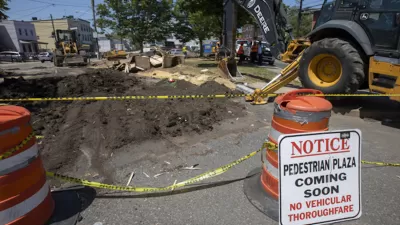The piece begins not in New York but three thousand miles west in Seattle with Janette Sadik-Khan explaining how she triumphed over auto interests by taking back precious road space and returning it to the people in the form of plazas and bike lanes.
Janette Sadik-Khan, New York City Transportation Commissioner under de Blasio's predecessor, Mayor Michael Bloomberg, "gets invited to talk about that work a lot, because a lot of cities around the U.S. want to do what New York did—despite the resistance of the auto-centric status quo," writes Sarah Goodyear for CityLab.
They want to give street space that has been dominated by cars back to people on foot or on bikes. They want public plazas with tables and chairs where people can eat lunch and chat and live their lives. New York’s efforts have become a national model.
"But now, allegedly because of some topless women who get tips by posing for pictures covered only in body paint and some rogue costumed characters, Mayor Bill de Blasio and his police chef, Bill Bratton, are talking about taking the plazas out, or at least re-evaluating them," she adds.
What’s chilling about de Blasio’s and Bratton’s treatment of the situation in Times Square is that it betrays a profound lack of understanding of just how important public space is for people in a dense urban environment such as New York.
Goodyear briefly describes the history of the landmark creation of the Times Square plaza, dating back to Sadik-Khan's 2009 vision, and includes excerpts from an eye-catching array of media coverage, both supporting (New York Daily News) and opposing (New York magazine, The New York Times, Times Square Alliance via POLITICO New York) the conversion of the plaza back to its original form since de Blasio's August 20 announcement.
The battle to reclaim street space from the auto goes far beyond Times Square. Consider signing a petition or two linked in a Streetsblog article if you feel strongly.
FULL STORY: A National Model for Better Streets Is Suddenly at Risk

Planetizen Federal Action Tracker
A weekly monitor of how Trump’s orders and actions are impacting planners and planning in America.

Congressman Proposes Bill to Rename DC Metro “Trump Train”
The Make Autorail Great Again Act would withhold federal funding to the system until the Washington Metropolitan Area Transit Authority (WMATA), rebrands as the Washington Metropolitan Authority for Greater Access (WMAGA).

DARTSpace Platform Streamlines Dallas TOD Application Process
The Dallas transit agency hopes a shorter permitting timeline will boost transit-oriented development around rail stations.

Renters Now Outnumber Homeowners in Over 200 US Suburbs
High housing costs in city centers and the new-found flexibility offered by remote work are pushing more renters to suburban areas.

The Tiny, Adorable $7,000 Car Turning Japan Onto EVs
The single seat Mibot charges from a regular plug as quickly as an iPad, and is about half the price of an average EV.

Supreme Court Ruling in Pipeline Case Guts Federal Environmental Law
The decision limits the scope of a federal law that mandates extensive environmental impact reviews of energy, infrastructure, and transportation projects.
Urban Design for Planners 1: Software Tools
This six-course series explores essential urban design concepts using open source software and equips planners with the tools they need to participate fully in the urban design process.
Planning for Universal Design
Learn the tools for implementing Universal Design in planning regulations.
Municipality of Princeton
Roanoke Valley-Alleghany Regional Commission
City of Mt Shasta
City of Camden Redevelopment Agency
City of Astoria
Transportation Research & Education Center (TREC) at Portland State University
US High Speed Rail Association
City of Camden Redevelopment Agency
Municipality of Princeton (NJ)



























